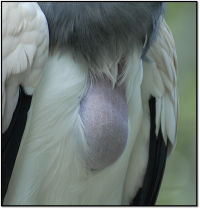This is an old revision of the document!
SPECIES PROFILE
KING VULTURE
Class: AVES
Order: ACCIPITRIFORMES
Family: CATHARTIDAE
Genus: SARCORAMPHUS
Species: PAPA

The only extant species in its genus, it is a new world vulture, sharing a common ancestor with the California Condor of genus Gymnogyps, the two having diverged perhaps some 10 million years ago, though known fossils belonging to the bird’s genus [including extinct species] date far later than this. Perhaps the most distinguished of the vultures - its main head is dark bluish, with patches of lighter blue, with yellow ornamentation above a reddish beak. Its neck is tinted with orange, yellow, and purple, with a bluish ‘mane’ of feathers. The body is more typical - plain white feathers, though the flight feathers of the wings and tail feathers are black. The exact origins of the bird's common name remain unclear - one theory refers to Mayan legend, where the bird was a 'king' between humans and gods - though another seems backed by an account by naturalist Charles Waterton - “The king of the Vultures came too, and I observed that none of the common ones seemed inclined to begin breakfast until his majesty had finished. When he had consumed as much snake as nature informed him would do him good, he retired to the top of a high mora-tree, and then all the common Vultures fell to and made a hearty meal.” Referring to how smaller [common] vultures seemingly would not eat from a carcass before the larger [king] vulture had done so. Though it could also be that the vulture gained its name from its comparative size and colouration compared to other smaller, drab vultures of the Americas. The genus-name, Sarcoramphus comes from two Greek root-words - Sarx, which means 'flesh', and Rhamphos, meaning 'beak', referring to the flesh-piercing beak of the bird. 'Papa' literally translates to 'Pope', but can also translate to 'larger', or 'ruler' - the ruler of flesh-eating birds.

One of the largest of the New-World vultures, King Vultures’ wings measure around 190 centimetres in length, and full animals may stand 80 or so centimetres in height, and weigh 4 kilogrammes. The species inhabits a wide range of Central and South America, inhabiting various habitats. Similar to other vultures, it possesses an impressive capability of flight, and is capable of soaring great distances without flapping. As do all other vultures, King Vultures feed on carrion - piercing animal skin with their firm, pointed beak. Also similar to other vultures, the species has good eyesight - though may prefer to trail other carnivores in search for food. As carrion may contain bacteria, the King Vulture's stomach is equipped with strong acids to kill off such bacteria, in addition to behavioural adaptation of basking in the sun to kill bacteria. In the case of large carcasses, numerous vultures may attend a carcass at a time - but aside of this, lack a sophisticated social structure. The species is monogamous, with a single egg guarded by both parents up to 60 days - after which both parents assume a role of raising the young. The chick is of a black-and-white colouration - gaining its colourful head plumage only at around 5 years of age, when they are independent of parents, and mature as so to produce their own offspring. It is not known to what age King Vultures reach in the wild, but birds do live up to 30 years in captivity. As is the case with other vulture species, King Vultures lack a syrinx - and so lack the ability to sing elaborate songs, though they may non-vocally grunt or hiss when threatened.
A colourful species, King Vultures are a popular species to be kept in zoos, where they breed well in large aviaries. General dietary fare for captive vultures includes such items as whole deer carcasses with the skin and bones still in place - but replicative of a natural lifestyle, the birds are not to be fed every day, as so they are able to digest the meal of the day before. King Vultures seem to have captivated humans since the time of Maya, where it appears common in Mayan folklore. It is not believed that the King Vulture is in significant threat in the wild, though it is thought that its population is decreasing in number due to human intervention.

